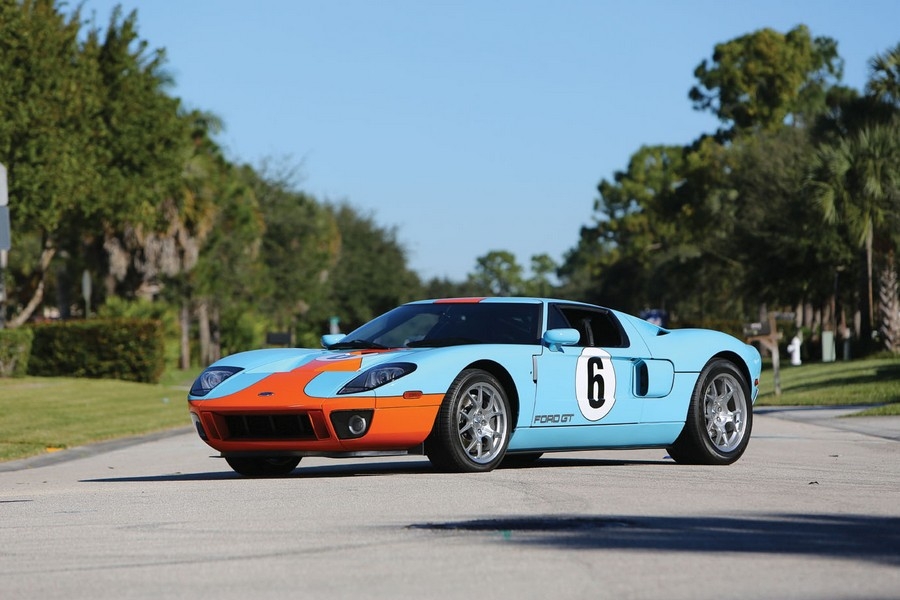SCM Analysis
Detailing
| Vehicle: | 2006 Ford GT Heritage Edition |
| Number Produced: | 4,038 |
| Original List Price: | $149,995 |
| Tune Up Cost: | $850 |
| Chassis Number Location: | Lower-left windshield corner |
| Engine Number Location: | Bar code sticker on valve cover |
| Website: | http://www.fordgt.org |
| Investment Grade: | A |
This car, Lot 548, sold for $412,500, including buyer’s premium, at Auctions America’s Fort Lauderdale, FL, auction on March 15, 2014.
To borrow from the old “Voyage to the Bottom of the Sea” script, the usual scenario for supercar values in the first decades after purchase is “Dive! Dive!” However the value curve for the Ford GT has defied convention ever since the model was launched for 2004. At first, the car’s value impressively held its own, with quickly flipped examples even surpassing their original MSRP.
Then they began to creep upward from there. Five years ago, in 2009, SCM tracked a 2005 model at the Bonhams auction in Sydney, Australia, that sold for $187,128 — a heady premium over the car’s original MSRP (SCM# 154426). And in 2012, at RM’s Dingman Collection sale, a 2005 model sold for $242,000, continuing the upward drive (October 2012, American Profile, p. 56). And now this Auctions America example, Lot 548, has hit $412,500 — a most impressive bump indeed.
What’s going on here?
Why this car? Many premium items are seeing strong gains right now, from collector cars to real estate to stocks. So the Ford GT is not alone in this area. Specific to this model though, I believe there are two factors in play here.
One is that America has produced so few exotic sports cars that took on the world’s best at Le Mans. In the post-war era, there were Cunninghams and Cobras, and Chaparrals, Corvettes, Vipers — and Ford GT40s. Not a long list, and the Ford GT40’s battles with Ferrari were legendary.
Discounting continuation Cobras and Daytona coupes as basically hobby cars, only the Ford GT was properly rekindled as a truly modern version of its former self. And it was a great model to pick for the honor, because the Ford GT40 stood very tall in its day.
Famously green-lighted by Hank the Deuce when Enzo rebuffed his overture to buy Ferrari, the original race car was one of the best antagonistic racing programs ever devised — build an American car, take it to Europe and destroy Ferrari’s grip on the most important sports car race in the world. The Ford GT40 did just that, not just once, but four times. As such, it earned a sweethearts-forever place in American car culture, and when Ford created the 4,000-odd re-dos, they were instantly in demand.
Second, this Ford GT was so authentic, so compassionately rendered, and such a good sports car. Compared with other, rather performance-deprived retro-cars, such as Plymouth’s PT Cruiser and Prowler and even Ford’s own Thunderbird, having one this good made people feel nothing but good themselves.
A classic modern car?
There is another possible factor that I’ll admit to have been wondering about for a while. Will computer-infested, thermoplastic-injection-molded, CAD/CAM robotically created, and DOT/NHSTA/EPA-certified cars ever achieve status as true classics? Although the advancement of such modern “plastic cars” into silly-money range is still likely incomprehensible to some, we could well be headed there, with cars such as the Ford GT leading the way.
Should this ever happen, it will strongly prove that high collector car prices are not necessarily driven by hand-beaten aluminum and twin-choke Webers, but rather emotion. The original mid-1960s Ford GT40 had this in spades, and the 2004–06 Ford GT repops do too.
At first, it seems the price paid for this fully optioned example was over the top. But considering that the car is among the best examples of the best commemorative-edition sports cars the U.S. — or any other country — has ever built, maybe it’s not over the top at all. But I’m still calling it really well sold. ♦
(Introductory description courtesy of Auctions America.)
[nggallery id=264]
